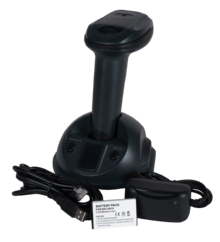Inventory control
Inventory control or stock control can be broadly defined as "the activity of checking a shop’s stock".[1] More specifically inventory control may refer to:
- In operations management, logistics and supply chain management, the technological system and the programmed software necessary for managing inventory
- In economics and operations management, the inventory control problem, which aims to reduce overhead cost without hurting sales. It answers the 3 basic questions of any supply chain: When? Where? How much?
- In the field of loss prevention, systems designed to introduce technical barriers to shoplifting
Stock control systems
Inventory control is also about knowing where all your stock is and ensuring everything is accounted for at any given time. An inventory control system or a computerized inventory system is a process for managing and locating objects or materials. In common usage, the term may also refer to just the software components. Many shops now use stock control systems. The term "stock control system" can be used to include various aspects of controlling the amount of stock on the shelves and in the stockroom and how reordering happens. Typical features of stock control software include:
- Ensuring that the products are on the shelf in shops in just the right quantity.
- Recognizing when a customer has bought a product.
- Automatically signalling when more products need to be put on the shelf from the stockroom.
- Automatically reordering stock at the appropriate time from the main warehouse.
- Automatically producing management information reports that could be used both by local managers and at head office.
These might detail what has sold, how quickly and at what price, for example. Reports could be used to predict when to stock up on extra products, for example, at Christmas or to make decisions about special offers, discontinuing products and so on. Sending reordering information not only to the warehouse but also directly to the factory producing the products enables them to optimize production.

Modern inventory control systems often rely upon barcodes and radio-frequency identification (RFID) tags to provide automatic identification of inventory objects. Inventory objects could include any kind of physical asset: merchandise, consumables, fixed assets, circulating tools, library books, or capital equipment. To record an inventory transaction, the system uses a barcode scanner or RFID reader to automatically identify the inventory object, and then collects additional information from the operators via fixed terminals (workstations), or mobile computers. The new trend in inventory management is to label inventory and assets with QR Code, and use smart-phones to keep track of inventory count and movement. These new systems are especially useful for field service operations, where an employee needs to record inventory transaction or look up inventory stock in the field, away from the computers and hand-held scanners.
Advantages and disadvantages
Stock control systems ensure that shelves are appropriately stocked. If there is too much stock, it ties up a company's money, money that might be better spent on reducing their overdraft, on advertising the business or on paying for better facilities for customers, for example. Too much stock means that some perishable products might not sell and would have to be thrown away and this would reduce a stock control system outweigh the disadvantages.
Inventory optimization
Inventory optimization is a method of balancing capital investment constraints or objectives and service-level goals over a large assortment of stock-keeping units (SKUs) while taking demand and supply volatility into account.
Inventory management software
Inventory management software is a computer-based system for tracking inventory levels, orders, sales and deliveries. It can also be used in the manufacturing industry to create a work order, bill of materials and other production-related documents. Companies use inventory management software to avoid product overstock and outages. It is a tool for organizing inventory data that before was generally stored in hard-copy form or in spreadsheets. It is often associated with and is similar to distribution software, as distributors that can compete with less cash tied up in inventories have a distinct advantage over their competitors.
See also
References
- ↑ "stock control - definition". Macmillan Dictionary. Retrieved 1 September 2013.